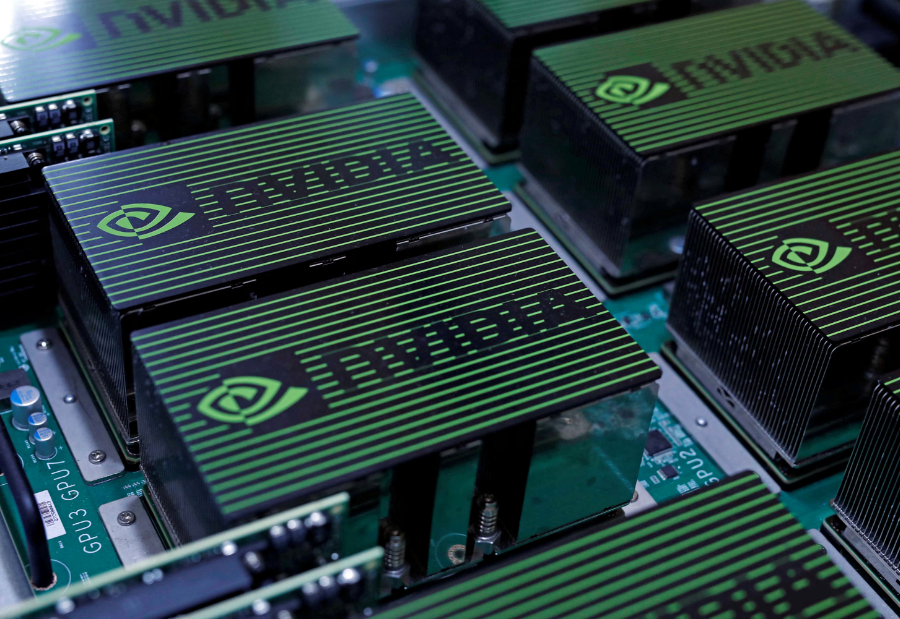Nvidia is developing a new artificial intelligence chip for China, based on its latest Blackwell architecture, which will be more powerful than the H20 model it is currently allowed to sell, according to two people briefed on the matter.
The new processor, tentatively named the B30A, will use a single-die design. This is expected to deliver roughly half the computing power of Nvidia’s top-end B300 accelerator card, which uses a dual-die configuration. A single-die design means all the key components of the integrated circuit are built on a single piece of silicon rather than spread across multiple units.
The upcoming chip will feature high-bandwidth memory and Nvidia’s NVLink technology for fast communication between processors. These capabilities are also part of the H20, a chip designed with Nvidia’s older Hopper architecture. Although the final specifications are not confirmed, Nvidia aims to provide samples to Chinese clients for testing as early as next month, the sources said.
In a statement, Nvidia said: “We evaluate a variety of products for our roadmap, so that we can be prepared to compete to the extent that governments allow.” The company also added: “Everything we offer is with the full approval of the applicable authorities and designed solely for beneficial commercial use.”
The development comes shortly after US President Donald Trump suggested that more advanced Nvidia chips could be sold in China, though regulatory approval is far from certain. Washington continues to express strong concerns about granting China greater access to advanced artificial intelligence technology.
Trump said last week he might permit Nvidia to sell a scaled-down version of its next-generation chip in China. He indicated the new model could have “30% to 50% off” in computing power, while describing the H20 as “obsolete”. This followed a landmark agreement requiring Nvidia and rival AMD to share 15% of their revenue from certain chip sales in China with the US government.
China accounted for 13% of Nvidia’s revenue in the last financial year, making the market crucial despite ongoing restrictions. Nvidia was only allowed to resume H20 sales in July, after being forced to halt shipments in April under tightened export rules. The H20 itself had been developed specifically for China following restrictions introduced in 2023.
The debate over Nvidia’s chips highlights one of the sharpest points of tension in US-China trade relations. Lawmakers in Washington, across both parties, have raised concerns that even reduced-performance chips could undermine America’s lead in artificial intelligence.
At the same time, Nvidia argues that maintaining Chinese interest in its chips is vital to prevent developers from turning fully to alternatives like Huawei. Analysts note that Huawei’s latest chips rival Nvidia in computing power but still trail in areas such as memory bandwidth and software ecosystem support.
Adding to Nvidia’s challenges, Chinese state media have recently alleged that its chips could pose security risks. Local authorities have also advised technology firms to be cautious when purchasing the H20. Nvidia has denied any backdoor risks in its products.
Separately, Nvidia is preparing another Blackwell-based chip tailored for China. This model, currently called the RTX6000D, is designed primarily for AI inference tasks. It will use conventional GDDR memory and provide bandwidth of 1,398 gigabytes per second, just under the 1.4 terabyte threshold set by US regulations earlier this year.
The RTX6000D will have weaker specifications and lower costs compared to the H20. Media reports in May indicated it would be priced below the H20, with production designed to stay within regulatory limits. Small batches are expected to be delivered to Chinese clients in September.
With these developments, Nvidia is attempting to balance its strategic roadmap with regulatory restrictions, while securing its market position in China amid rising competition and political scrutiny.
Also read: Viksit Workforce for a Viksit Bharat
Do Follow: The Mainstream formerly known as CIO News LinkedIn Account | The Mainstream formerly known as CIO News Facebook | The Mainstream formerly known as CIO News Youtube | The Mainstream formerly known as CIO News Twitter |The Mainstream formerly known as CIO News Whatsapp Channel | The Mainstream formerly known as CIO News Instagram
About us:
The Mainstream formerly known as CIO News is a premier platform dedicated to delivering latest news, updates, and insights from the tech industry. With its strong foundation of intellectual property and thought leadership, the platform is well-positioned to stay ahead of the curve and lead conversations about how technology shapes our world. From its early days as CIO News to its rebranding as The Mainstream on November 28, 2024, it has been expanding its global reach, targeting key markets in the Middle East & Africa, ASEAN, the USA, and the UK. The Mainstream is a vision to put technology at the center of every conversation, inspiring professionals and organizations to embrace the future of tech.




